11/5/13--Jaipur to Ranthambhore National Park
It’s another early wake up call, another early breakfast and on the bus by 7. We drive south east from Jaipur into the country – still hazy, but I can make out the dream like state with farmlands broken up by small towns and villages. Prahbu tells us about the gods in the Hindu religion, Gnash, and how the caste system came to be until Gandhi put a stop to it. He also talked about the recently reported rapes in India and laws – very wise thinking man. We learn about the crops – mangos, barley, others I can’t recall and houses – what it was like when he was little. Along the road we see families, farmers and gypsies.

On the road to Ranthambhore |

On the road to Ranthambhore |

On the road to Ranthambhore |

On the road to Ranthambhore |

On the road to Ranthambhore |

On the road to Ranthambhore |

On the road to Ranthambhore |

On the road to Ranthambhore |

On the road to Ranthambhore |

On the road to Ranthambhore |

On the road to Ranthambhore |

On the road to Ranthambhore |

On the road to Ranthambhore |

On the road to Ranthambhore |

On the road to Ranthambhore |

On the road to Ranthambhore |

On the road to Ranthambhore |

On the road to Ranthambhore |

On the road to Ranthambhore |

On the road to Ranthambhore |

On the road to Ranthambhore |

On the road to Ranthambhore |

On the road to Ranthambhore |

On the road to Ranthambhore |
At noon, we arrive at our hotel nestled in the foothills of 'Aravali ranges' neighboring Ranthambhore National Park. Boy-oh-boy, the Alsisar Nahargarh hotel is a palace! We can’t believe this place. It is surrounded by a 16th century-style fortress and is built like a traditional Rajput hunting palace complete with a vast formal Mughal garden and the perfect place to explore the National Park. Have a look at these photos – It is the fanciest place we’ve ever stayed.

Nahargarh Ranthambhore Hotel |

Nahargarh Ranthambhore Hotel |

Nahargarh Ranthambhore Hotel |

Nahargarh Ranthambhore Hotel |

Nahargarh Ranthambhore Hotel |

Nahargarh Ranthambhore Hotel |

Nahargarh Ranthambhore Hotel |

Nahargarh Ranthambhore Hotel |

Nahargarh Ranthambhore Hotel |

Nahargarh Ranthambhore Hotel |

Nahargarh Ranthambhore Hotel |

Nahargarh Ranthambhore Hotel |

Nahargarh Ranthambhore Hotel |

Nahargarh Ranthambhore Hotel |

Nahargarh Ranthambhore Hotel |

Nahargarh Ranthambhore Hotel |

Nahargarh Ranthambhore Hotel |

Nahargarh Ranthambhore Hotel |

Nahargarh Ranthambhore Hotel |

Nahargarh Ranthambhore Hotel |

Nahargarh Ranthambhore Hotel |

Nahargarh Ranthambhore Hotel |

Nahargarh Ranthambhore Hotel |

Nahargarh Ranthambhore Hotel |
We have lunch at 12:30 and then take an optional trip to the Ranthambhore Fort – a spectacular fortress built more than 1,000 years ago on a rocky outcrop with stunning views. It is in the middle of the Nahargarh Tiger Preserve. We ride in an open four-wheel drive jeep-type vehicle known locally as a “canter” and hang on for dear life as we go over the bumps. We see a couple of crocodiles and lots of monkeys and then a couple of dear. We also see pilgrims walking along the road, going for a blessing at one of the ancient temples perched on a hill.

Canter |

Driving to the Fort |

Driving to the Fort |

Driving to the Fort |

Driving to the Fort |

Driving to the Fort |

Langur monkeys |

Langur monkeys |

Driving to the Fort |

Driving to the Fort |
We park at the foot of a walled city and hike to the top. We pass temple after temple -- Ganesha, Raj, Jain, and Lakshmi Narayan -- all crawling with Langur monkeys and believers. Because of the holiday, the temple is a hopping place. At the main Gnash temple, we receive a blessing from a wise looking old guy. I see worshippers reading a list of strange words – later I learn they are reciting all 108 names for Ganesha.

Fort Ranthambhore |

Fort Ranthambhore |

Fort Ranthambhore |

Fort Ranthambhore |

Fort Ranthambhore |

Fort Ranthambhore |

Fort Ranthambhore |

Fort Ranthambhore |

Fort Ranthambhore |

Fort Ranthambhore |

Fort Ranthambhore |

Fort Ranthambhore |

Fort Ranthambhore |

Fort Ranthambhore |

Fort Ranthambhore |

Fort Ranthambhore |

Fort Ranthambhore |

Fort Ranthambhore |

Fort Ranthambhore |

Fort Ranthambhore |

Fort Ranthambhore |

Fort Ranthambhore |

Fort Ranthambhore |

Fort Ranthambhore |
On the way down the hill, I get to know some of the India families here on holiday. They want to have their photo taken with me, the strange Westerner. They also want to know my name and age and if I like India. I answer the age part truthfully and have a great time making new friends.

India families |

India families |
We return from our late afternoon at the ancient temples. We retreat to our HUGE palace hotel room to shower and get ready for dinner. Bill does the laundry and I catch up on emails.
Dinner is delightful. We sit across from Kai and Woo and learn yet another fascinating fact about Woo – He is a champ at fantasy football. The surprises never end with that guy.
After dinner, we watch a documentary about tigers in the open courtyard. I snooze and hopefully, don’t snore.
Early wake up call for the safari tomorrow.
11/6/13 – Safari Day in the Ranthambore National Park
The wake-up call comes at 5:45 with breakfast at 6:15. Then by 7, we’re in the canter (safari truck) and ready to go. We meet Mazrath, our naturalist guide. He is terrific – very passionate about his work and quite handsome as well. He was a poor village kid with a zest for wild life and nature. He is self-educated and now does research and publishes articles. He wrote an article about saving T-24 (a tiger) after the tiger killed 3 people out gathering wood. (Check it out on FelineConservation.) I could tell that the other naturalists had great respect for him. He is smart and really knows his stuff – and the tigers that live in the park.

In the canter |

Mazrath, our naturalist guide |
We enter the park, along with streams of pilgrims on foot who are headed to the ancient temples for blessings.

Streams of Pilgrams |

Streams of Pilgrams |
The Ranthambore National Park, located near the town of Sawai Madhopur, is one of the eleven sites chosen for Project Tiger, India’s national tiger conservation program -- the largest such effort in the world. The park covers more than a hundred square miles of deciduous forest and several large lakes. Until 1970, the park was a hunting preserve of the maharajas.
Mazrath tells us that 24 tigers make their home in the preserve, 45 in the entire area. With fondness, he shares stories of some of the tigers. He said that “Lady of the Lake,” now 18, with a life expectancy of 12 years, still rules the lake area. She has markings like a fish on her face. Her face and teeth were once ripped out by crocodiles, but she learned to hunt using her claws to bring the predators down. Although post-menopausal, she still rules.
Mazrath said that another tiger, referred to as T-23, killed 3 people, just for the heck of it – not for food. In spite of this, Mazrath campaigned to save his life. T-23 also killed a stack of crocodiles just for sport. T-23 marks his territory by claw marks and by peeing – to mark his territory. He leaves his claw marks on a tree to show his height and size of nails. Our hotel is in his territory and T-23 has been spotted on the premises.
Mazrath said that tiger behaviors are changing quickly and perplexing the researchers. Some tigers are teaming, watching out for each other and sharing the position of top tiger. Mazrath doesn’t know if environment conditions are causing the changes in behaviors, or perhaps it’s the tiger adapting to its shrinking territory.
The Ranthambore National Park has 5 zones. Our safari vehicle is assigned to zone 5 – a way of distributing the crowds throughout the park. However, I think we kept changing to zone 4 for a better chance to see tigers. We also had to change plates on the vehicle. The goal of the safari is to spot a tiger – something everyone hopes for.
Zone 5 has 3 or 4 manmade lakes. The trees that line the lakes must be hardy to withstand water. The lakes are beautiful, one with red moss / algae – good feed for the birds. The areas around the lakes are very peaceful, in spite of the crocodiles. A dozen crocodiles, confiscated from poachers, were introduced here in 1972. Now there are about 450 in the park. The mother crocodile lays 35 eggs at a time with only 5 to 8 survive into baby crocs.

Ranthambore National Park |

Ranthambore National Park |

Ranthambore National Park |

Ranthambore National Park |

Ranthambore National Park |

Ranthambore National Park |
The safari started off on an upbeat note when Mazrath found a fresh tiger paw print in the dust along the side of the road. It was fun to watch him listen to all the sounds of the other animals and birds, signaling perhaps a tiger is entering their area. With Mazrath’s eagle eye to guide us, we dash around the park, hoping for a tiger sighting.

Ranthambore National Park |

Ranthambore National Park |

Ranthambore National Park |

Ranthambore National Park |
After a while, the excitement wears down. Then we are content to see a variety of birds and animals. 450 species of birds frequent this area – like the egret, owl, etc. Mazrath spotted a Golden Back spider web. Golden Back spiders are very social, among themselves.
Some the animals we see that morning are the Spotted Back deer, Blue Bull antelope, a couple of crocodiles, Langur monkeys (always cunning), wild bores with babies, a Jackal, and Saber deer – one in particular was making advances to a female without any response.

Ranthambore National Park |

Ranthambore National Park |

Ranthambore National Park |

Ranthambore National Park |

Ranthambore National Park |

Ranthambore National Park |

Ranthambore National Park |

Ranthambore National Park |

Ranthambore National Park |

Ranthambore National Park |

Ranthambore National Park |

Ranthambore National Park |

Ranthambore National Park |

Ranthambore National Park |

Ranthambore National Park |

Ranthambore National Park |
EUREKA! We get to see T-24 (Tiger #24) just as we were leaving. Because I’m overdue for cataract surgery, I only see her out in the open for a maximum of about 3 seconds. Everyone wants a peek. We are surrounded by excited pilgrims on foot going to the temple and all manner of other safari vehicles with screaming passengers. Excitement is contagious!

Streams of Pilgrams |

Streams of Pilgrams |
We say good-bye to the park and our brief encounter with T-24 and drive back to the hotel. Judy and I have a decadent, delightful massage at the SPA and then we have lunch in the elegant dining room. Life is so very Goooooood!
At 2:15, we meet Mazrath again at the safari vehicle for another afternoon of game-viewing. He continues to impress us with his knowledge of tigers. However, we are not so lucky because we are assigned to Zone 5 again. Also, our new driver is fast and furious and not as gentle as our morning driver. The jungle grows up from limestone, making the roads very bumpy – all we felt every bump that afternoon. We all need a chiropractic adjustment when he got through with us! However, we do manage to see some more animals along the way.

Ranthambore National Park |

Ranthambore National Park |

Ranthambore National Park |

Ranthambore National Park |

Ranthambore National Park |

Ranthambore National Park |
Mazrath points out an ancient carving of an ox from eons ago. It is well worn and I never would have guessed its importance. The stone ox is just out by the road – a reminder that this park is not just about the wildlife, but a very spiritual place.

Stone Ox |
It’s the start of winter, mating season, and a busy time of year for some deer. Mazrath points out a large mud hole – just like a sink hole – by the road. The deer created it just by licking. It serves as their pick up bar. They rub their bodies in the hole leaving their chemical scent behind – much like leaving a calling card – “If you like my smell, let’s get together. “ Seems like there’s got to be an easier way.

Ranthambore National Park |

Ranthambore National Park |
Just as our safari is almost over, someone spots a couple of tigers– and the excitement level immediately rises. There is a big traffic jam blocking the views. Only Ann and David, who sat at the back of the van, got to see one of the tigers. Although they were only brief encounters with the tigers, it’s pretty amazing to spot a tiger on both safaris. We go back to the hotel very happy.

Ranthambore National Park |

Ranthambore National Park |
There is a lovely BBQ waiting for us outside in one of the hotel’s courtyards. The dishes served up from the grill are tasty and the evening is perfect. We sat with Bran, David, Judy, Woo and Kai. We stayed up late to talk to Woo and Kai and their bout with war in Korean – amazing couple.
Back to the room to pack for tomorrow – really hate to leave this palace.
11/7/13--Ranthambore to the OAT Camp
After breakfast in the beautiful, kingly dining room, we load onto the bus for a full day of adventure.

On the bus |
We first drive to town (Ranthambore), and then stroll through a small village. The children are excited and want me to take their pictures. Although their clothes are tattered and worn, their smiles are bright and their eyes sparkle. Such beautiful, joyful creatures – just like the Little Rascals. One kid carries his little brother and does not put him down. Half of my attention goes to Prahbu‘s walking dialogue about the town and half goes to the beautiful children.
Cows, dogs, pigs, chickens and other sorts of farm animals roam the village lanes at will. Prahbu shows us the village temple, bank, governmental office / clinic, homes, and other stores along the way. We laugh at the signs posted on the government building -- “Keeping clean keeps germs away” And “2 children is enough!” Prahbu shows us the items one buys at the little local store -- coloring books, packaged tobacco to roll your own and packets of cream entitled “Fair and Lovely.” (I want dark and exotic.)

Ranthambore Village |

Ranthambore Village |

Ranthambore Village |

Ranthambore Village |

Ranthambore Village |

Ranthambore Village |

Ranthambore Village |

Ranthambore Village |

Ranthambore Village |

Ranthambore Village |

Ranthambore Village |

Ranthambore Village |

Ranthambore Village |

Ranthambore Village |

Ranthambore Village |

Ranthambore Village |
Our next stop is the local school where we meet the principle and kids. Kindergarteners through the 8th grade attend the school. Today is a school holiday, but the kids follow us into the school to count, recite poems and the alphabet. They were absolutely charming … and very smart.

School near Renthambore |

School near Renthambore |

School near Renthambore |

School near Renthambore |

School near Renthambore |

School near Renthambore |

School near Renthambore |

School near Renthambore |
We peeked into the dark classrooms, then climb up to the rooftop and looked down at the classrooms. It was here on the roof that Bill talked to the principal about educational system in India and I took of photos of some students and photos of the little town from above. Then we say good-bye to the local village and walk down the dust road to the farmer’s house.

Ranthambore Village |

Ranthambore Village |

Ranthambore Village |

Ranthambore Village |

Ranthambore Village |

Ranthambore Village |

Ranthambore Village |

Ranthambore Village |

Ranthambore Village |

Ranthambore Village |

Ranthambore Village |

Ranthambore Village |
To get to the farmer’s house, we turn off the main road and walk through farms and cows and oxen and neatly formed and stacked piles of cow dung. The farmer is a big, jovial guy and very cocky. We enjoy tea and cookies at his newly remodeled house. (He did it for Diwali.) His grandson leads us through the gardens – squash, olma (hard, round green tangerine-sized balls) good for vitamin C and hair conditioner, guavas, and other misc. stuff. It is great fun to tromp through the fields on a cool, morning.

Farm House Near Ranthambore |

Farm House Near Ranthambore |

Farm House Near Ranthambore |

Farm House Near Ranthambore |

Farm House Near Ranthambore |

Farm House Near Ranthambore |

Farm House Near Ranthambore |

Farm House Near Ranthambore |

Farm House Near Ranthambore |

Farm House Near Ranthambore |

Farmer |

Farmer's son |
We board the bus and head on down the road to Dhonk, a women’s cooperative that makes hand crafted goods – scarves, blouses, shirts, skirts, printed cloth, just to name a few. The cooperative was started to help poachers’ wives to have a means of supports – because their husbands are in jail serving time for poaching. Dhonk now takes in abused women as well and gives them their freedom by training them to make handcrafted goods.

Dhonk Women’s Cooperative |

Dhonk Women’s Cooperative |

Dhonk Women’s Cooperative |

Dhonk Women’s Cooperative |
We all buy a lot of things – for me, a blouse, a dress for Zion and other gifts for girlfriends. After our collective buying spree, they serve us lunch outside -- very pleasant. We end by getting our hands painted with henna. Mine lasts about 1 minute. I pick up my camera, the strap slides down my arm to my freshly painted hand and smudges the painted design before it has time to dry. I go around looking like a bird just crapped on my hand – oh well.

Henna Painting |

Cow |
After lunch, we board the bus and settle in for a long, 4-hour bumpy ride to our next stop – The Aagman India Camp, owned by OAT. The day is very hazy – according to Prahbu, it’s not pollution, but caused by a change in the weather patterns.
We drive along small plots of land used by local farmers to grow a diversity of crops – mustard, onions, potatoes, guavas, etc. The farmland is broken up by busy market places packed with holiday celebrations. I photograph amazing scenes right outside my bus window.

Road to OAT Camp |

Road to OAT Camp |

Road to OAT Camp |

Road to OAT Camp |

Road to OAT Camp |

Road to OAT Camp |
We make a bathroom stop and then are followed by the aggressive salespeople out to get one’s rupees. They are very unpleasant people not bothered at all by rejection. Our next bathroom stop is much more pleasant. We get to see an amazing Hindu Temple – southern Indian style.

Hindu Temple |

? |
We make a most delightful stop at Abhaneri to see an ancient baolis, or a step-well. It is one of the oldest Baori (step well) in Rajasthan built by King Chandra who ruled Abaneri during 9th- 9th Century A.D. This waterway was built to provide a constant water supply to the locals about 1500 years ago. I’ve seen a lot in my travels but never anything like this. The Taj Mahal and Amer Fort may be more magnificent in the structure itself, but this felt like discovering a hidden gem.
The palace and the steps down into the well were built close to a riverbank that is completely dry these days. The steps are carved in a very symmetrical manner on three sides all the way down to about 65 feet, with the palace and balconies above the steps on the fourth side. It's amazing how this was all accomplished in the 8th-9th century AD.

Abhaneri baolis (Step Well) |

Abhaneri baolis (Step Well) |

Abhaneri baolis (Step Well) |

Abhaneri baolis (Step Well) |
At the top surrounding the step well is a huge collection of stone artwork depicting figures like the Hindu Holy Trinity of Brahma, Vishnu and Mahesh. Unfortunately, like many other ancient stoneworks throughout India, faces of most of these deities have been disfigured during the period of Muslim rule in India.

Abhaneri baolis (Step Well) |

Abhaneri baolis (Step Well) |
We walk a short distance to the little village where we meet a potter. Among other clay items, he makes little clay cups by the dozens. Here, in India, they are like disposable cups used by the little coffee or tea stops on almost every corner. Our stop was fun because Lena tried her hand at the wheel. She’s a doctor traveling with her parents and an absolute delight to have along.

Clay Pot Making |

Clay Pot Making |

Clay Pot Making |

Lena Learning a New Skill |
After we checked off the clay adventure, we load back on the bus for the last leg of our trip today. Of course I busy myself with taking photographs – lots of them. (I’ll try to spare you.)

Scenes from the Bus |

Scenes from the Bus |

Scenes from the Bus |

Scenes from the Bus |

Scenes from the Bus |

Scenes from the Bus |
Finally, about 4:30, we arrive at the OAT Camp and are greeted by the staff and a drum roll. The place is set up just like the camps in Africa with individual tents, each with their own bathroom. After a welcome drink of lemonade, we find our tent - #6 - and unpack. The camp is in a peaceful setting. The campsite is nestled among small plots of land used by local farmers to grow a rich diversity of crops.

OAT Camp |

OAT Camp |

OAT Camp |

OAT Camp |

OAT Camp |

OAT Camp |
We settled into our camp just as it starts to rain. Luckily, at 5:30, the rain stops in time for us to enjoy some tasty snacks at the fire ring. Then we go into the dining room for a cooking demonstration. Prabhu shows us his cooking skills, while the top chef, a guy from Nepal, looks on. Kai rolls out the flat bread to perfection. A good time was had by all. A better time was had at the bar where we woof down our Kingfisher beer.

OAT Camp |

OAT Camp |

OAT Camp |

OAT Camp |
A nice dinner comes next where we sample some of the food Prabhu made – potato spinach curry. We sit with David and Judy. Yeah -- a dish of ice cream for dessert, nice American touch.
After dinner, we gather again at the fire ring to watch a gang of about 10 guys sing folk songs and dance. “Guys Dancing” is part of the tradition that started eons ago when guys harvesting in the fields needed a little entertainment. So, in the evenings, they’d make up songs and dances. The singing was haunting, but the dancing was joyful and crazy, with lots of versions of Michael Jackson’s moon walking thrown in. One of the guys was constantly throwing kerosene into the fire – much to the delight and horror of the group. One of dancers danced with some our gals – Judy, Jan and Lena. They were fun to watch, but even more fun was dancing together with the group, flanging our arms and legs around.

OAT Camp |

OAT Camp |

OAT Camp |

OAT Camp |
After the camp fire is put out, we wander back to our tents, carrying hot water bottles to keep our feet warm in bed. I pile on the clothes thinking we were in for freezing weather – turns out, I wake up in the middle of the night extremely hot and quickly toss off my jacket, long pants and socks. It is a kick sleeping in the tent. We were warned that we’d hear jackals crying all night. Turns out the village folk sang and chanted, making quite a racket, drowning out any yelping jackals. The next morning we learn that the commotion came from a nearby funeral, with grievers mourning most of the night. Had we known … we would have been more understanding.
11/8/13 -- Oat Camp to Day to Agra
We have breakfast and then mount our camels for a ride through the countryside. Bill and the other guys in our group are fitted with their own turbans – had a lot of fun with that. It reminds Bill of my father, may his soul rest in peace, and one of his favorite pejorative terms “camel jockeys.” Bill was the cutest “camel jockey” of the group.

Camel Jockeys |

Camel Jockeys |

Camel Jockey Bill |

Camel Jockey David |
It is a beautiful day and I’m happy as can be, watching life in the country from high above on my camel. We see farmers in the fields, kids waving from their houses and kids taking their morning showers at the town’s water hole. The sunlight is crisp and perfect for photographer’s eye and the smell of the country is delightful. In spite of what I was told, camel riding is a very pleasant experience. (I did pick the shortest camel of the lot – easier to mount and dismount.)

Camel Ride |

Camel Ride |

Camel Ride |

Camel Ride |

Camel Ride |

Camel Ride |

Camel Ride |

Camel Ride |

Camel Ride |

Camel Ride |

Camel Ride |

Camel Ride |

Camel Ride |

Camel Ride |

Camel Ride |

Camel Ride |
Right after the camel ride, we board the bus for Agra, ancient capital of the Mughal Empire. For the first hour or so of the bus ride, Prahbu tells us the history of how the Mughals came to occupy and dominate this region for 190 years before the British took control. Prahbu is a brilliant story teller and teacher.
As we drive, Prahbu points out features of the land. As we approach the river, The Great and Mighty Ganges River, the terrain gets flatter and the soil gets darker and richer. The building construction also changes. Here, with no mountains, there are no marble and sandstone buildings. Many brick factories dot the landscape turning out bricks. Everything now is made of bricks. We see the ancient mile markers placed 2 miles apart, as part of the Mughal main route with a caravansary at every 10th marker. We see cow patties perfectly shaped and ready for sell and we see a cool guy enjoy his cup of tea.

Heading to Agra |

Heading to Agra |

Heading to Agra |

Heading to Agra |
So much to observe from the window from my air conditioned bus, I document many scenes – India is a swirl and color and a swirl of life.

Heading to Agra |

Heading to Agra |

Heading to Agra |

Heading to Agra |

Heading to Agra |

Heading to Agra |
We hit a huge traffic jam on the outskirts of Agra. A truck overturned. Our bus driver is very skilled and aggressive and hates to be stuck in traffic. He looks like he needs a good stiff drink.

Heading to Agra |

Heading to Agra |
We finally arrive at the palatial 5 star hotel, Jaypee Palace Hotel, but only have 30 minutes to clean up and meet at the lobby for a moonlight garden tour of the Taj Mahal.

Jaypee Palace Hotel |

Jaypee Palace Hotel |

Jaypee Palace Hotel |

Jaypee Palace Hotel |
We hit major traffic in the ancient city of Agra, but the first view of the Taj Mahal makes it all worth it. The white shimmering white marble mausoleum sends shivers through my body. No words can describe it – it is indeed a paradise on earth. We walk down the gardens added by the British for the lavish parties they threw at the Taj. Everyone is dazzled by the Taj Mahal, and cannot believe that they are actually here. The photo snapping session is joyful. We are desperately seeking the perfect picture by the Taj to prove we were really here.

Taj Mahal |

Taj Mahal |
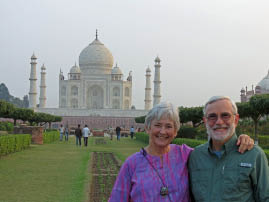
Taj Mahal |

Taj Mahal |

Taj Mahal |

OAT Group |
Finally, we lose the light and walk back to the bus. The sky fills with birds coming home to roost in the trees in the garden. Prahbu said they are crows – but they didn’t look or sound like any crows I know of.
We sit in traffic another hour before we are free from ancient Agra. I spend my time watching unbelievable scenes – monkeys climbing in and out of windows of ancient buildings, water buffalo with horns painted red, vehicles packed with people, cows being cool as only they can be in India and no one showing any fear of dying out there in those streets.

Agra Traffic |

Agra Traffic |

Agra Traffic |

Agra Traffic |

Agra Traffic |

Agra Traffic |

Agra Traffic |

Agra Traffic |

Agra Traffic |

Agra Traffic |
We make our way to another lovely restaurant. Bill and I are lucky again to get to sit next to Woo and Kai – a most remarkable couple.
We go back to our rooms. I do the journal while Bill does the wash. I can’t believe the wonderful day, starting with a camel ride in the country and ending in the shadow of the Taj Mahal – Oh my word!
11/9/13--Agra, Taj Mahal and the Red Fort
We rise very early – no time for breakfast. We scurry onto the bus by 6:15 and then arrive at the Taj Mahal about ten minutes later … Next the gals wait for over an hour in the ladies line to be frisked. I mean really frisked, and then we can join our guys on the grounds of the Taj. The ladies line takes much longer because of all the bags to be checked. This country is serious about security.
From Prahbu we learn that Taj Mahal was built by Mughal Emperor Shah Jahan as a tomb for the love of his life, his third wife Queen Mumtaz Mahal. She died bearing their 14th child. The Taj was under construction for 17 years, starting in 1631. It employed 22,000 artisans and workers and over 1,000 elephants to transport the construction materials. The unemployment rate for the region took a big dip during those years.
Shah Jahan was one of the Mughal rulers. He had a couple of wives and a daughter, but they just weren’t doing it for him. Then he meets and marries Mumtaz and only has eyes for her. In about 16 years of marriage, they have 14 kids. (Prahbu said she wasn’t able to see her feet through all those years of marriage – just a little Indian humor tossed in.)
Mumtaz was on a military campaign with her Mughal emperor husband in southern India. There she delivered child #14 when things went terribly wrong and she died. Shah Jahan was overcome with grief and went back to Agra (the capital) to build her a tomb. It would be a great shrine and a monument to love. The Taj Mahal is a magnificent, elegant building with a beautiful love story.
As a side story -- out of the 14 children, 6 survived – 4 sons and 2 daughters. The youngest son was a total brutal brat and quite paranoid. He wanted to become king so he pitted his brothers against each other. He said his Dad, King Shah Jahan, was losing touch and spending buckets of bucks on the Taj Mahual and that the brothers should come quickly and overthrow him. The mislead brothers meet and did battle with each other. One died, while he, the bratty baby of the family, hung back. Later, he killed the other two remaining brothers. He then returned to Agra and put his father (Shah Jahan) in the Agra Fort under house arrest. Shah Jahan was confined to 2 palace rooms with a view of the Taj Mahaul just beyond the Yumuna River, so the aging King could peer at his beloved wife’s tomb for the rest of his life. After he died, he was buried next to her.
I digress – now back to the Taj Mahaul. It is said that there are two types of people in this world – those that have seen the Taj Mahal and those who haven’t. I’m proud to be included in those who have. The four sides of the Taj Mahal, covered in white glowing marble, are perfectly identical and truly a marvel. It is pure symmetry – except that her tomb is centered with his tomb off to the side. We enter the gate and look over the gardens to see the Taj Mahual shrouded in fog – which burns off fairly quickly, thank goodness. Bill and I hound some people to take photos of us with the Taj behind. We go to the inner platform and see the bench where Princess Diana sat to be photographed with a smile on her face, but sadness in her eyes. (We all know the rest of the story.)
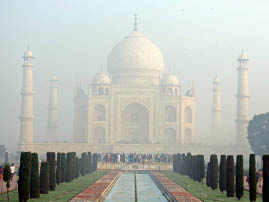
Taj Mahal |
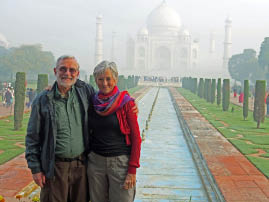
Taj Mahal |
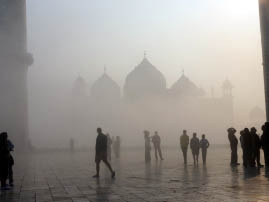
Taj Mahal |

Taj Mahal |
We climb the stairs to the main building, put on our booties and enter the tomb. It is loud. I see many taking photos just below the “No Photos” and “Quiet Please” signs. We peer through the marble carved screen to see Mumtax’s marble monument centered with the king to the side. They are buried directly beyond these markers, one story down. The stairs are blocked and no one is allowed to go to the actual graves.
Once on the outside, I take photos of the semi-translucent white marble inlaid with thousands of semi-precious stones in beautiful patterns. The British took many of the precious stones, the spoils of war, after their conquest in the early 1800’s. The building is in perfect symmetry framed by 6 minarets and flanked by two large, identical buildings – one a mosque and one a large entry way. Except for the missing precious stones, the building is in beautiful shape – recently cleaned in 2006.

Taj Mahal |
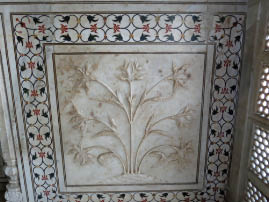
Taj Mahal |
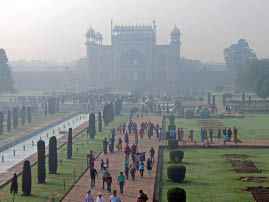
Taj Mahal |
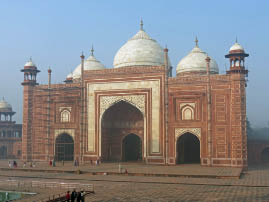
Taj Mahal |
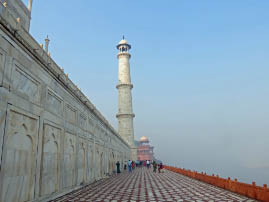
Taj Mahal |
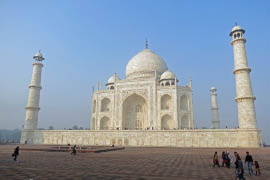
Taj Mahal |
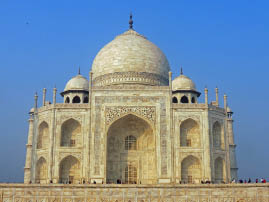
Taj Mahal |
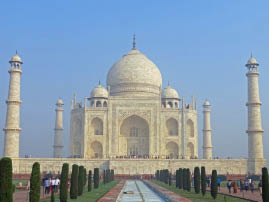
Taj Mahal |
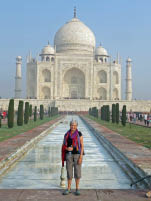
Taj Mahal |
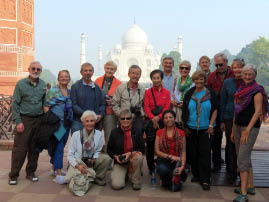
OAT Group at Taj |
After the British took control of the region, they planted a more proper garden. The Taj was the party place for the British “back in the day.” The Taj is the symbol of India – a symbol that carries great pride.
After our individual explorations, we meet the group at 9 a.m. and find our way (riding a packed tram) back to the bus. We arrive at the Jaypee Palace in time for a massive, buffet breakfast.
At 11, we meet again at the bus to go to Agra Fort, a huge, sprawling fort / palace on the banks of the Yamuna River. The fort was so solidly built and cleverly designed that no one ever attacked it. Starting with a moat stocked with hungry crocodiles, proceeding through 3 massive gates, one with huge boulders ready to roll down an incline to wipe out any soldier.
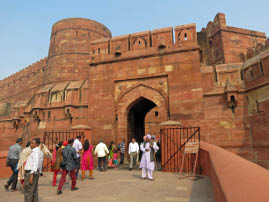
Agra Fort |

Agra Fort |

Agra Fort |

Agra Fort |
This immense fort and palace were once the seat of power for four generations of Mughal emperors. They ruled all of northern India from the early 16th century until the consolidation by the British colonial rule in the early 1800’s – The fort is 450 years old.
Our entrance into the fort felt pure military. When the British took over with the colonial rule, they put up their soldiers in these barracks. Today soldiers are still housed here.
The architect changes abruptly when we enter the palace section. We are blown away by the size and grandeur. From the outside, the fort looks boring and practical, but inside there are beautiful green gardens everywhere. It was one of the most peaceful places I’ve been. The palace and king’s quarters, along with the massive harems exude beauty. The views from the palace are incredible. We see where the elderly disposed king lived out his last two years with only a view of the Taj Mahaul to comfort him – the place where he enshrined his beloved queen.

Agra Fort |
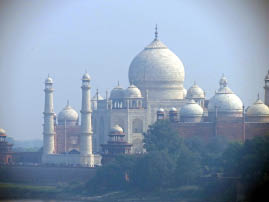
Agra Fort |
We marvel at the marble carvings, arched ceilings, water carpet, series of water falls through the massive gardens where grapes once grew. We see where the king held audience with the people and where the chain of justice (1605) was pulled to request to see the king. The chain was 80 feet long, made of pure gold with 60 bells attached – connected to a rock down below and bells up above in the palace. If folks, no matter what caste or creed, poor or rich, passing down by the river had a grievance, they would rattle the chain, to notify the highest judicial authority in the palace. There was no fee or fear of retaliation. The chain existed for many years and was a legend in Indian history. The Mughals ruled in style for over 90 years. I leave the Fort, crowded with tourists, with a new insight and appreciation for India’s amazing history and culture.
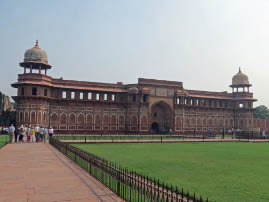
Agra Fort |

Agra Fort |
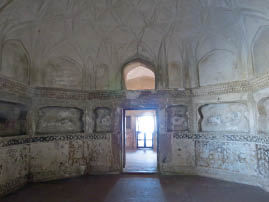
Agra Fort |
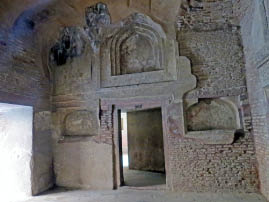
Agra Fort |
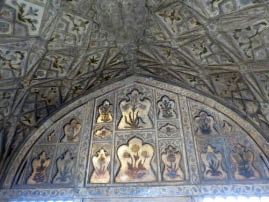
Agra Fort |
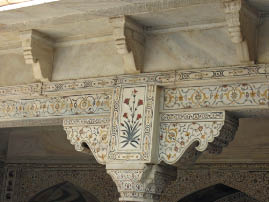
Agra Fort |
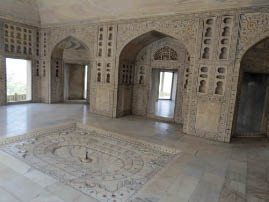
Agra Fort |
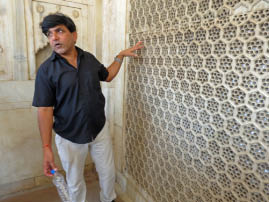
Agra Fort |

Agra Fort |
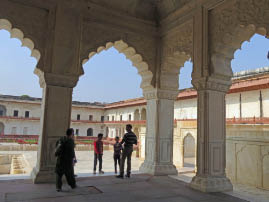
Agra Fort |
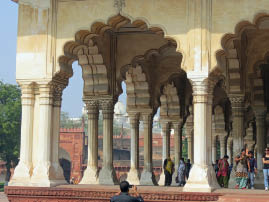
Agra Fort |
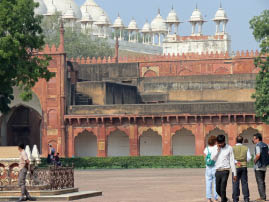
Agra Fort |
Our next stop is a shop where we can buy precious stones carved into marble. We sit through a demonstration. I completely zone out. I respect the artistry of these guys, but I don’t want any of the stuff. The main spokesperson / chief salesman is a godfather type. I’m sure he was descended from the meanest of Mughals. He did offer us free drinks, including beer, which softens the experience. The work was beautiful – but way out of sight, even for most of our moneyed traveling buddies. A wall decoration runs you about $40,000 – about what you’d pay for a Lexus. After they hit us with the big stuff, they guide us into an affordable gift shop where the items started at two to three hundred. I was glad to get back on the bus.

Marble Shop |

Marble Shop Godfather |
We make a couple of stops at ATM’s, because our traveling buddies are running short on cash. We come back to the room for 3 hours of catch up. We check our emails, get packed, do some journaling, and then take a walk around the luxurious grounds of the hotel. Everything is picture perfect – the green grassy knolls, beautiful gardens, tennis courts and swimming pools … and guards with serious rifles. The hotel property is lined with a high barbed wire fence. We see kids next door standing on their slum rooftops waving and smiling at us from over the high fence. They seem so happy.

Jaypee Palace Hotel |
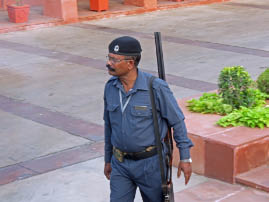
Jaypee Palace Hotel |

Jaypee Palace Hotel |

Jaypee Palace Hotel |
We have enough of our paradise grounds. The grass is indeed MUCH GREENER here. We go to Tapas, the hotel bar, for a beer.
Dinner is at 7:30 – buffest style, of course. This is the life.
We come back to the room to pack and get ready for an early wake up call.
11/10/13--Long, long travel day.
We arrive at the train station and watch the people while we wait. I see such interesting faces – faces I love to photograph. I also see a father pinching his baby to make him cry. A crying baby apparently improves one’s begging abilities. Prahbu gathers us around and warns us that we only have 5 minutes to board the train, so when the train arrives, we all make a mad dash.
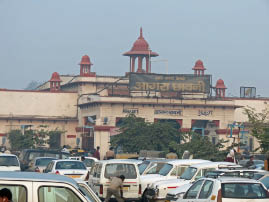
Agra Train Station |
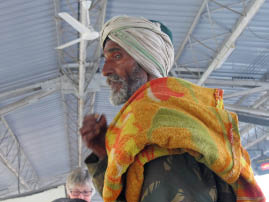
Agra Train Station |
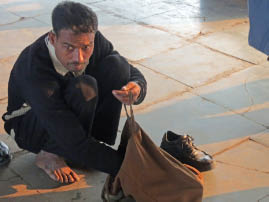
Agra Train Station |
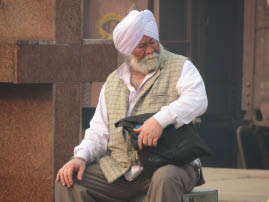
Agra Train Station |
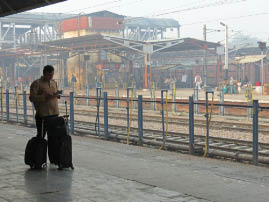
Agra Train Station |
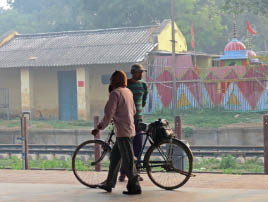
Agra Train Station |
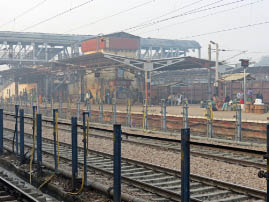
Agra Train Station |
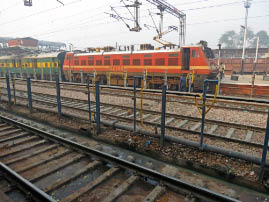
Agra Train Station |
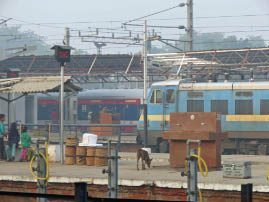
Agra Train Station |
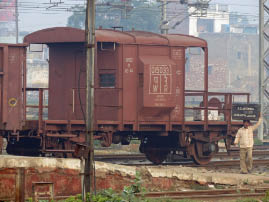
Agra Train Station |
The train ride is two hours. I sit by Ann and have a nice long conversation. She is very interesting and has a NGO in Uganda--Concern for the Girl Child--where she helps girls. The train windows are very dirty so I can vaguely make out the scenes of the countryside interspersed with few villages – but I always spot the women moving about in their colorful sarees.

On the Train |

On the Train |

On the Train |

On the Train |
At the train station in Jhansi (center of Bundela civilization), we board a bus, another nice, big roomy bus. We drive for 2.5 hours over a very bumpy road to Alipura.
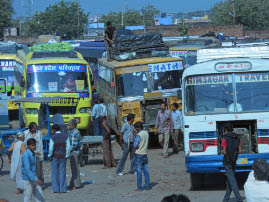
Lunch Stop |
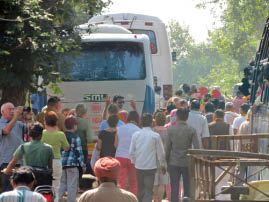
Lunch Stop |
Our lunch stop is a lovely surprise. It’s at a palace, or rather a hunting lodge built about 60 years ago by a Brundela ruler. The colorful tile work reminds me of Spain. We have a typical buffet lunch, but the soup, naan and ice cream make it special and memorable.

Lunch Stop |

Lunch Stop |
After lunch, we stop to see a farmer use a team of water buffalo to lift the water from the well. This very old system of irrigation works well. With all that water trickling around, I must find a spot to pee. The bushes next to the carrot patch serve the purpose. The fertile fields produce several crops.

Water Wheel |

Water Wheel |

Water Wheel |

Water Wheel |
We still have over two to three hours left to go on a very bumpy road. The main bridge is missing, but luckily, the skilled bus rider is able to drive off the road and into a dry, sandy riverbed. I thought for sure we’d get stuck, but he makes it through and saves us 30 kilometers. My fellow travelers are all troopers – not one complaint.
We arrive at our hotel, Radisson Jass Hotel – Khajuraho, around 7 p.m. Prahbu was happy with the good time we made. We are happy to be there -- the hotel is lovely.

Radisson Jass Hotel |
It was a long, hard travel day to get to Khajuraho, the heart of central India in a very remote location – but it is well worth the effort. Tomorrow we get to see a group of temples, a UNESCO World Heritage Site, with Karma Sutra worship and pornographic carvings a’plenty. |











